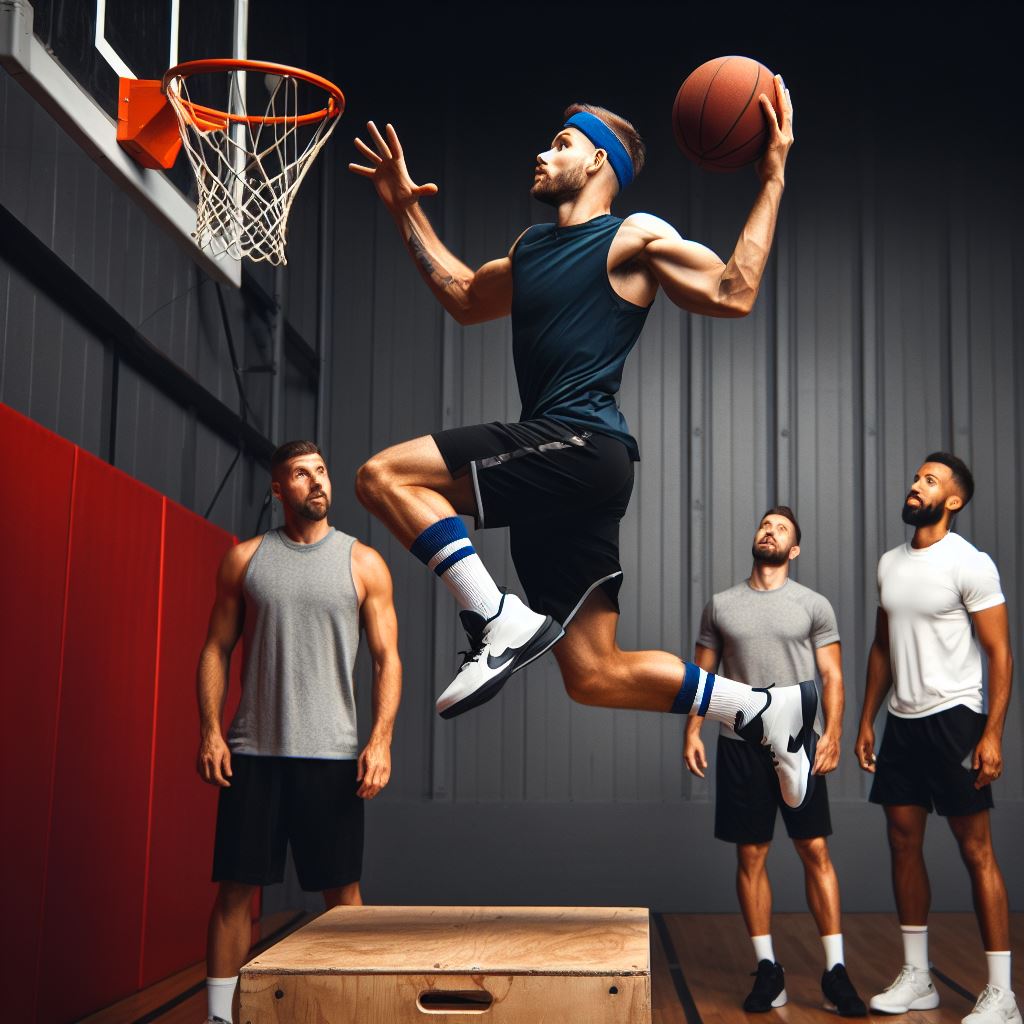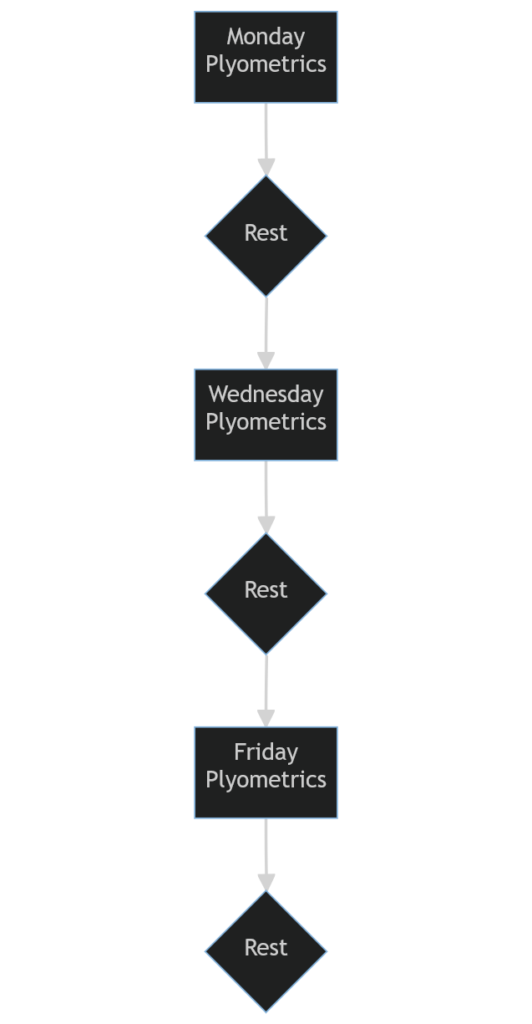
New Research Shows Plyometric Training Significantly Boosts Jumping in Basketball Players, leading to improvements in other athletic attributes such as sprint speed, quickness, balance, and strength.
📝 Introduction
As any basketball player knows, the ability to jump high is a huge asset on the court.
Whether going up for a rebound or throwdown dunk, getting extra air can be the difference between making the highlight reel or getting stuffed.
But is there a way to train your vertical leap beyond simple jump reps?
🎓 Key Findings:
- Jump Height: Plyometric training can increase countermovement jump height by an average of 24%.
- Age Factor: Players aged 16 and above benefited more than their younger counterparts.
- Other Improvements by Plyometric Include:
- Player’s Balance: A 25% improvement in static balance (standing still) and a 22% boost in dynamic balance (balance while in motion), as gauged by the Y Balance Test.
- Player’s Agility (Quickness): 19% quicker completion of agility drills involving rapid movements.
- Player’s Strength: A 12% rise in the maximum weight lifted in exercises like squats. Additionally, a better hamstring-to-quad strength ratio was observed, which is crucial for preventing injuries.
Clarifications:
- 1RM: Represents the maximum weight one can lift in a single repetition of exercises like squats. This strength increased by 12% with plyometric training.
- Y Balance Test: Measures how far you can reach to touch a marker in different directions while standing on one leg. This tests dynamic balance.
| In the Study, Plyo Training Helps Improve | How Much Better? |
|---|---|
| Jumping | Countermovement jump by +24% |
| Squat jump by +21% | |
| Drop jump by +18% | |
| Horizontal jump by +28% | |
| Sprinting | Short sprints (≤10 m) by +25% |
| Longer sprints (>10 m) by +15% | |
| Agility | Short distances (≤40 m) by +19% |
| Longer distances (>40 m) by +16% | |
| Balance | Dynamic by +22% |
| Static by +25% | |
| Strength | Maximal by +12% |
🧠 Why It Works:
Plyometric exercises utilize the stretch-shortening cycle of muscles to enhance power.
When you land from a jump and rapidly take off again, your muscles stiffen like a spring, generating more explosive force.
This allows you to jump higher over time as your nervous system and muscles adapt to the plyometric stress.
📊 Application & Implications
Basketball players looking to boost their vertical leap can incorporate plyometric jumps like box jumps, broad jumps, and squat jumps into their training routines 2-3 days per week.
Coaches may find greater benefits in older players from plyometric programs.
The meta-analysis indicates plyometrics provide an advantage over other training methods for improving jump height.
✋ Limitations
The studies focused on basketball athletes so results may differ for other sports.
More research is still needed on optimal volume and recovery for plyometrics to maximize gains and minimize injury risk.
🏢 Real-world Examples
- LA Lakers center Dwight Howard increased his vertical leap several inches using plyometrics
- WNBA star Brittney Griner credits plyos for her ability to dunk
⚡ Steps to Implement
- Warm up thoroughly before plyometric training
- Start with lower-intensity drills like hops and skipping before progressing to jumps
- Focus on proper landing technique – land softly on the balls of your feet
- Allow at least 48 hours between plyometric sessions for recovery
- Start with 2 sessions/week and build up to 3 over time

🔍 Study Details
- Study Type: Meta-analysis of 32 studies on plyometric training
- Title: The effects of plyometric jump training on physical fitness attributes in basketball players: A meta-analysis
- Source: Journal of Sport and Health Science
- Researchers: Rodrigo Ramírez-Campillo, University of Los Lagos, Chile
Frequently Asked Questions
Q1: How much can plyometrics increase my vertical jump?
A: Based on the meta-analysis, basketball players can expect around a 24% increase in countermovement jump height on average after a plyometric program. So if your starting vertical is 20 inches, that could add almost 5 inches!
Q2: Is plyometric training safe? What about risk of injury?
A: When programmed appropriately starting with low intensities, plyometrics have a relatively low injury rate. Proper coaching supervision and landing technique are key to safety. Allowing at least 2 days rest between sessions can help minimize injury risk as well.
Q3: How often should I do plyometric workouts to increase jumping ability?
A: The researchers recommend 2-3 plyometric sessions spaced out during the week. This provides adequate training stimulus while allowing sufficient rest and recovery between sessions.
Q4: Why might plyometrics provide greater gains in older basketball players?
A: The study found players over 16 had significantly greater improvements in horizontal jump distance from plyometrics than younger players. This may be because they have more muscular development and neural adaptations possible beyond changes in the nervous system alone.
Q5: What other athletic abilities can plyometrics improve besides vertical jump?
A: Plyometrics have been shown to enhance sprint speed, change of direction, balance, and strength as well. So they can provide multi-faceted athletic benefits beyond just jump height. The key is ensuring proper progression and recovery to optimize gains across different fitness attributes.
Bottom Line
Plyometric training is more effective than other methods for improving vertical leap based on the research.
The science shows plyometric training is excellent for increasing vertical jump in basketball players. By incorporating a few plyometric sessions per week and allowing enough recovery time, you can expect big gains in how high you can jump and perform on the court.
Reference
Ramirez-Campillo, R., García-Hermoso, A., Moran, J., Chaabene, H., Negra, Y., & Scanlan, A. T. (2022). The effects of plyometric jump training on physical fitness attributes in basketball players: A meta-analysis. Journal of sport and health science, 11(6), 656–670. https://doi.org/10.1016/j.jshs.2020.12.005







